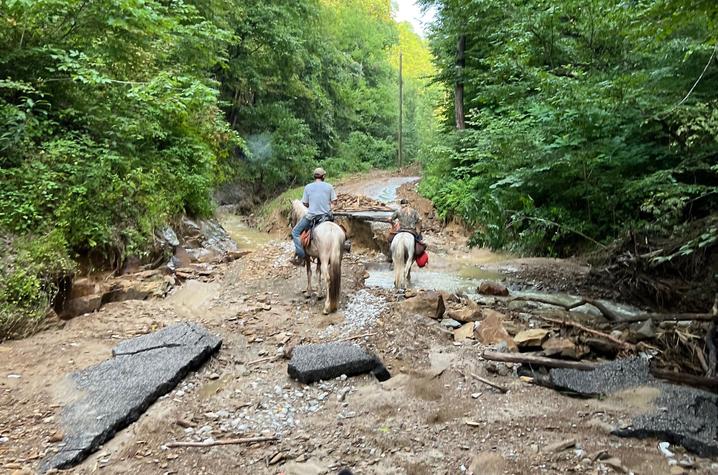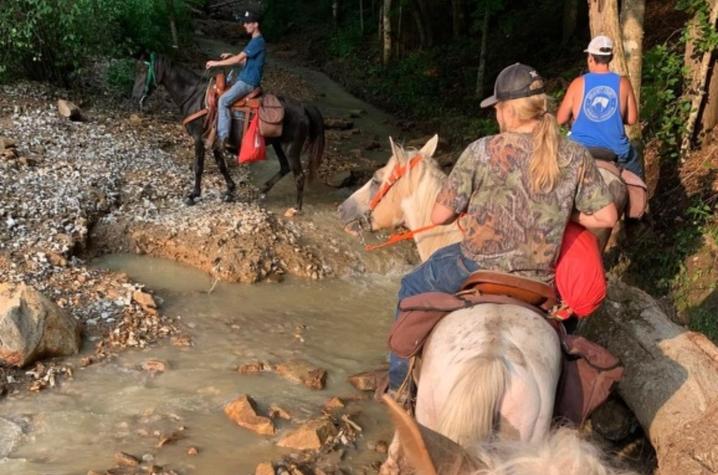Flood relief teams rely on horses to reach survivors stranded in Eastern Kentucky
HAZARD, Ky. (Sept. 2, 2022) — It’s a phrase made famous by beloved TV host Fred Rogers: “Look for the helpers.”
For many people stranded in their homes tucked in the hills of Eastern Kentucky following July’s catastrophic flooding, some of “the helpers” arrived on four legs.
“(These people) had not seen another human in a couple of days,” said local horse trainer Hunter Stidham.
Stidham is one of several members of the Breathitt Horseman’s Association who knew they could help as they watched their community grapple with the aftermath of the flood.
“They actually told us they didn’t think we would make it to some of these places on horses,” said Stidham. “We made it.”
One of the homes that had been cut off from everything else — due to washed out culverts and roads in addition to the mud slides happening all around — was home to a newborn baby.
“The baby was just a few weeks old,” said Stidham “We were able to get baby supplies and bottled water to them.”
SUVs, side-by-sides and ATVs could only get so far in many areas, leaving dozens of Eastern Kentuckians — many who were without power and running water — without any outside access to necessities or refuge.
*****
April Stamper has lived in the Buckhorn community of Perry County her whole life. She is the school nurse and was doing everything she could to help in the immediate aftermath of portions of her hometown being wiped away.
At that point, Stamper was helping operate what she calls a small Band-Aid station for people to come to if they sustained any cuts or injuries trying to get out of the floodwater. They soon realized, though, that many people could not get to them.
“We had not even started to clean up. It was just survival. Everybody was trying to get what they needed,” said Stamper. “And then Hunter and his friends showed up when there were virtually no roads to travel on.”
The team of helpers continued to grow. They assembled bags of food and other necessities for Stidham and the other riders on horseback to deliver to those who were stranded.
“The first day we rode almost 30 miles,” said Stidham. “We went up in hollers where there was no way to get in or out … except by horse.”
As they delivered supplies, the horse teams could also check and take note of specific things — like medications — that people needed.
UK HealthCare’s Key Douthitt, M.D., helped coordinate a lot of moving parts while also providing care as the medical director at North Fork Valley Clinic in Hazard.
“I’m trying to focus on the medical side of things, knowing there are others out helping get the needed supplies together, and figuring out how we are going to get the necessities to those stuck in their homes,” Douthitt said. “Together, we are taking care of the whole person.”
Meanwhile, Stamper and other health care workers were trying to get tetanus vaccines to those who had been in floodwaters. They were able to access some people on ATVs, even if that required going as far as they could on ATV and then making the rest of the trek on foot. Makeshift vaccine clinics also popped up all around the area for those who could get out of their homes.
“Everyone was just in shock. This has never happened before and we couldn’t believe what we were in the midst of,” said Stamper. “Complete strangers just showed up. They would say ‘I’m a nurse, I can help give shots.’ Or those who didn’t have a health care background still wanted to help and did things like unload trucks and pallets of water. It was just something that everybody ought to be able to witness. And the kids, the younger generation … they have been amazing.”
At 18 years old, Stidham falls into that category. He took what he knows best — horses — and found a way to help. “We have the horses, so why not use them?” he said. “We knew we could help people by using them.”
Leaders within UK’s College of Agriculture, Food, and Environment say they are proud of the actions of Stidham and other members of the horseman’s association, which is part of the Breathitt County Cooperative Extension.
“It really warms your heart. They put aside projects in their lives to help others in need,” said Breathitt County extension agent Reed Graham. “Horses are a great means of transportation, and they always have been. They can often navigate tough terrain while keeping balance and carrying extremely heavy loads. That can go a long way in providing essential services to people otherwise cut off from the outside world.”
In addition to helping move supplies, Graham says members have been boarding horses free of charge for community members while they get their lives back in order. “The Breathitt County Horseman’s Association is a great group, and they have really been there for the community in need,” said Graham.
*****
As the weeks have passed, the stories of helpers and their ingenuity continue to add up. Like the teams navigating tricky hillsides with horses and pack mules or making it through a washed-out road in a Jeep, or a pulley system that was rigged up to get needed medication across a swollen creek that had washed out all bridges.
Some helpers came on horseback, some came with nursing backgrounds, some came with ATVs, some came with strength to move supplies. They all came with a willingness to help wherever and however they were able.
“After all our people have been through, that’s the least we can do,” said Douthitt.
“Sometimes it was like a nightmare, and you just kept going back each day,” said Stamper. “There was never a question about going back, or even any time to be sad or worried. It happened, and everybody just got together to push forward each day.”
As the state’s flagship, land-grant institution, the University of Kentucky exists to advance the Commonwealth. We do that by preparing the next generation of leaders — placing students at the heart of everything we do — and transforming the lives of Kentuckians through education, research and creative work, service and health care. We pride ourselves on being a catalyst for breakthroughs and a force for healing, a place where ingenuity unfolds. It's all made possible by our people — visionaries, disruptors and pioneers — who make up 200 academic programs, a $476.5 million research and development enterprise and a world-class medical center, all on one campus.







